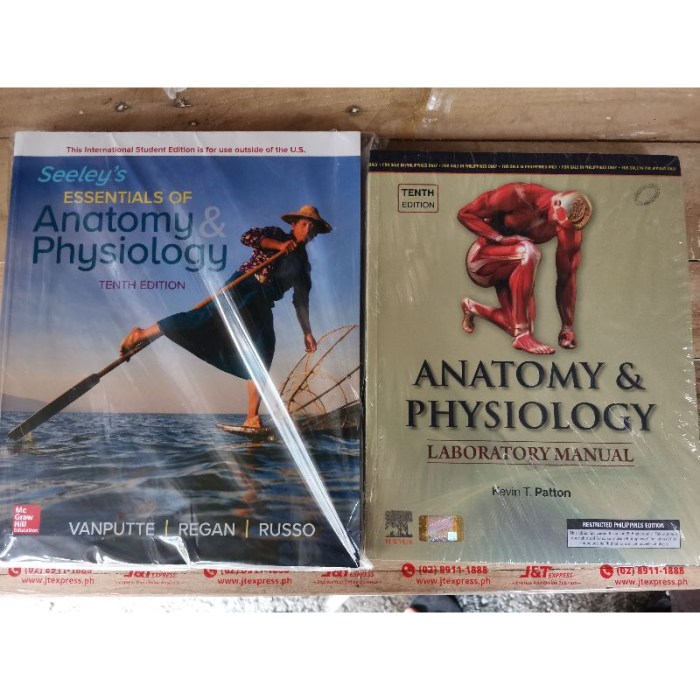Embark on an extraordinary journey through the human body with Fundamentals of Anatomy & Physiology 10th Edition. This comprehensive text provides a captivating exploration of the intricate systems that govern our physical existence, empowering readers with a profound understanding of their own biology.
Delve into the fascinating world of anatomy, where the structure and organization of the human body are meticulously examined. Uncover the secrets of physiology, unraveling the dynamic processes that maintain life and orchestrate our every action. Prepare to be amazed by the human body’s remarkable complexity and resilience.
Anatomical Terminology and Basic Concepts

Anatomical terminology is a standardized set of terms used to describe the human body. It is essential for clear communication among healthcare professionals.
Anatomical Position
The anatomical position is a standardized reference point for describing the body. In the anatomical position, the body is standing erect, with the arms at the sides and the palms facing forward.
Planes of the Body
The body is divided into three planes: sagittal, coronal, and transverse. The sagittal plane divides the body into left and right halves. The coronal plane divides the body into anterior and posterior halves. The transverse plane divides the body into superior and inferior halves.
Directional Terms
Directional terms are used to describe the location of one body part relative to another. The most common directional terms are:
- Anterior: front
- Posterior: back
- Superior: above
- Inferior: below
- Medial: toward the midline of the body
- Lateral: away from the midline of the body
Body Cavities
The body is divided into two main cavities: the dorsal cavity and the ventral cavity. The dorsal cavity contains the brain and spinal cord. The ventral cavity is divided into the thoracic cavity, the abdominal cavity, and the pelvic cavity.
Basic Tissues of the Body
The body is composed of four basic tissues: epithelial tissue, connective tissue, muscle tissue, and nervous tissue.
- Epithelial tissue covers the surfaces of the body and lines the cavities of the body.
- Connective tissue supports and connects the other tissues of the body.
- Muscle tissue allows the body to move.
- Nervous tissue transmits information throughout the body.
The Skeletal System: Fundamentals Of Anatomy & Physiology 10th Edition

The skeletal system is the framework of the body. It supports the body, protects the internal organs, and allows for movement.
Structure and Classification of Bones
Bones are composed of hard, calcified tissue. They are classified into four types: long bones, short bones, flat bones, and irregular bones.
- Long bones are longer than they are wide. They are found in the limbs.
- Short bones are cube-shaped. They are found in the wrist and ankle.
- Flat bones are thin and flat. They are found in the skull, ribs, and pelvis.
- Irregular bones have a complex shape. They are found in the vertebrae and facial bones.
Major Bones of the Axial and Appendicular Skeletons
The axial skeleton is composed of the bones of the head, neck, and trunk. The appendicular skeleton is composed of the bones of the limbs.
- The major bones of the axial skeleton are the skull, vertebrae, ribs, and sternum.
- The major bones of the appendicular skeleton are the clavicles, scapulae, humeri, ulnae, radii, carpals, metacarpals, phalanges, femurs, patellae, tibiae, fibulae, tarsals, metatarsals, and phalanges.
Process of Bone Formation and Growth, Fundamentals of anatomy & physiology 10th edition
Bones are formed through a process called ossification. Ossification begins in the embryo and continues throughout childhood and adolescence. The process of bone growth is regulated by hormones.
The Muscular System
The muscular system is responsible for movement. It is composed of muscles, which are contractile tissues.
Structure and Function of Muscles
Muscles are composed of muscle fibers, which are long, thin cells. Muscle fibers contain actin and myosin filaments, which slide past each other to cause muscle contraction.
Types of Muscles
There are three types of muscles: skeletal muscles, smooth muscles, and cardiac muscles.
- Skeletal muscles are attached to bones and are responsible for voluntary movement.
- Smooth muscles are found in the walls of organs and are responsible for involuntary movement.
- Cardiac muscles are found in the heart and are responsible for the pumping action of the heart.
Mechanisms of Muscle Contraction and Relaxation
Muscle contraction is initiated by a nerve impulse. The nerve impulse causes the release of calcium ions into the muscle fiber. Calcium ions bind to actin and myosin filaments, causing them to slide past each other and shorten the muscle fiber.
Muscle relaxation occurs when the nerve impulse stops and calcium ions are pumped back into the sarcoplasmic reticulum.
Major Muscle Groups of the Body
The major muscle groups of the body are the:
- Muscles of the head and neck
- Muscles of the trunk
- Muscles of the upper limbs
- Muscles of the lower limbs
Q&A
What is the scope of Fundamentals of Anatomy & Physiology 10th Edition?
This text provides a comprehensive overview of human anatomy and physiology, covering all major body systems and their functions.
Who is the intended audience for this book?
Fundamentals of Anatomy & Physiology 10th Edition is suitable for students in healthcare programs, as well as individuals interested in gaining a deeper understanding of the human body.
What are the key features of this edition?
This edition includes updated content, new illustrations, and interactive learning tools to enhance the learning experience.